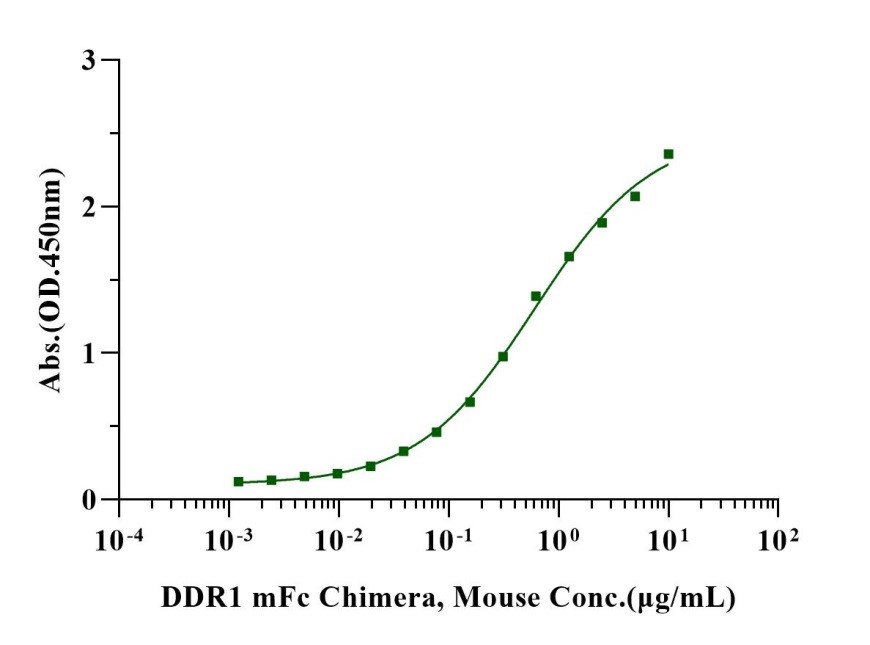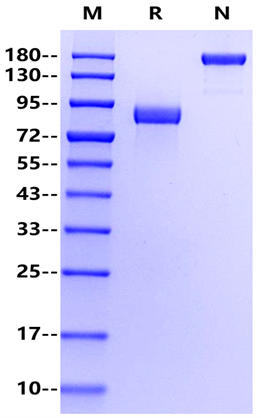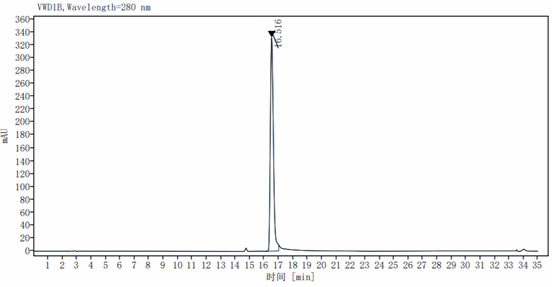Immobilized Cell AdhereTM Type I collagen, Human, Lyophilzed at 2.0μg/mL (100μL/well) can bind DDR1 mFc Chimera, Mouse (Cat. No. UA010130) with EC50 of 0.48-0.84μg/ml.
Product Details
Product Details
Product Specification
| Species | Mouse |
| Synonyms | Discoidin domain receptor 1 |
| Accession | Q03146-1 |
| Amino Acid Sequence |
Asp22-Thr414, with C-terminal Mouse IgG2a Fc DMKGHFDPAKCRYALGMQDRTIPDSDISVSSSWSDSTAARHSRLESSDGDGAWCPAGPVFPKEEEYLQVDLRRLHLVALVGTQGRHAGGLGKEFSRSYRLRYSRDGRRWMDWKDRWGQEVISGNEDPGGVVLKDLGPPMVARLVRFYPRADRVMSVCLRVELYGCLWRDGLLSYTAPVGQTMQLSEVMVHLNDSTYDGYTAGGLQYGGLGQLADGVVGLDDFRQSQELRVWPGYDYVGWSNQSFPTGYVEMEFEFDRLRTFQTMQVHCNNMHTLGARLPGGVECRFKRGPAMAWEGEPVRHALGGSLGDPRARAISVPLGGHVGRFLQCRFLFAGPWLLFSEISFISDVVNDSSDTFPPAPWWPPGPPPTNFSSLELEPRGQQPVAKAEGSPTIEGRMDPEPRGPTIKPCPPCKCPAPNLLGGPSVFIFPPKIKDVLMISLSPIVTCVVVDVSEDDPDVQISWFVNNVEVHTAQTQTHREDYNSTLRVVSALPIQHQDWMSGKEFKCKVNNKDLPAPIERTISKPKGSVRAPQVYVLPPPEEEMTKKQVTLTCMVTDFMPEDIYVEWTNNGKTELNYKNTEPVLDSDGSYFMYSKLRVEKKNWVERNSYSCSVVHEGLHNHHTTKSFSRTPGK |
| Expression System | HEK293 |
| Molecular Weight | 78-93kDa (Reducing) |
| Purity | >95% by SDS-PAGE&RP-HPLC |
| Endotoxin | <0.1EU/μg |
| Conjugation | Unconjugated |
| Tag | Mouse Fc Tag |
| Physical Appearance | Lyophilized Powder |
| Storage Buffer | PBS, pH7.4 |
| Reconstitution | Reconstitute at 0.1-1 mg/ml according to the size in ultrapure water after rapid centrifugation. |
| Stability & Storage | · 12 months from date of receipt, lyophilized powder stored at -20 to -80℃. · 3 months, -20 to -80℃ under sterile conditions after reconstitution. · 1 week, 2 to 8℃ under sterile conditions after reconstitution. · Please avoid repeated freeze-thaw cycles. |
Background
Discoidin domain receptor 1 (DDR1) belongs to a subfamily of tyrosine kinase receptors with an extracellular domain homologous to Dictyostellium discoideum protein discoidin I which are activated by various types of collagens. Receptor tyrosine kinases play a key role in the communication between cells and their microenvironment and they are involved in the regulation of cell growth, differentiation and metabolism. Expression of DDR1 is restricted to epithelial cells, particularly in the kidney, lung, gastrointestinal tract and brain. In addition, DDR1 has been shown to be significantly overexpressed in several human tumors, and it has been demonstrated to be able to promote tumor invasion and metastasis and being closely related to tumor immune infiltration. Alternatively spliced transcript variants encoding different isoforms have been described for this gene.
Picture
Picture
Bioactivity

SDS-PAGE

RP-HPLC







